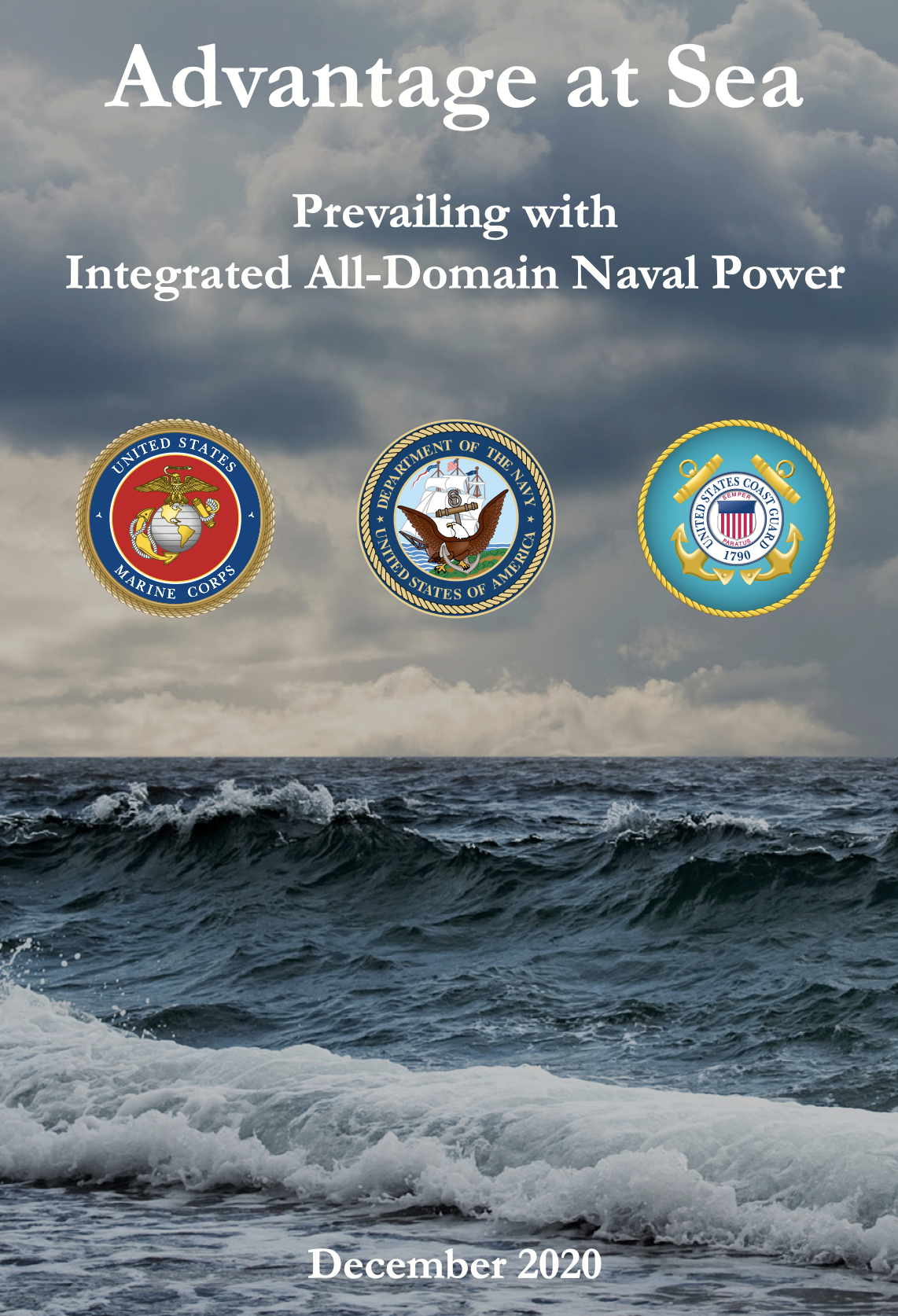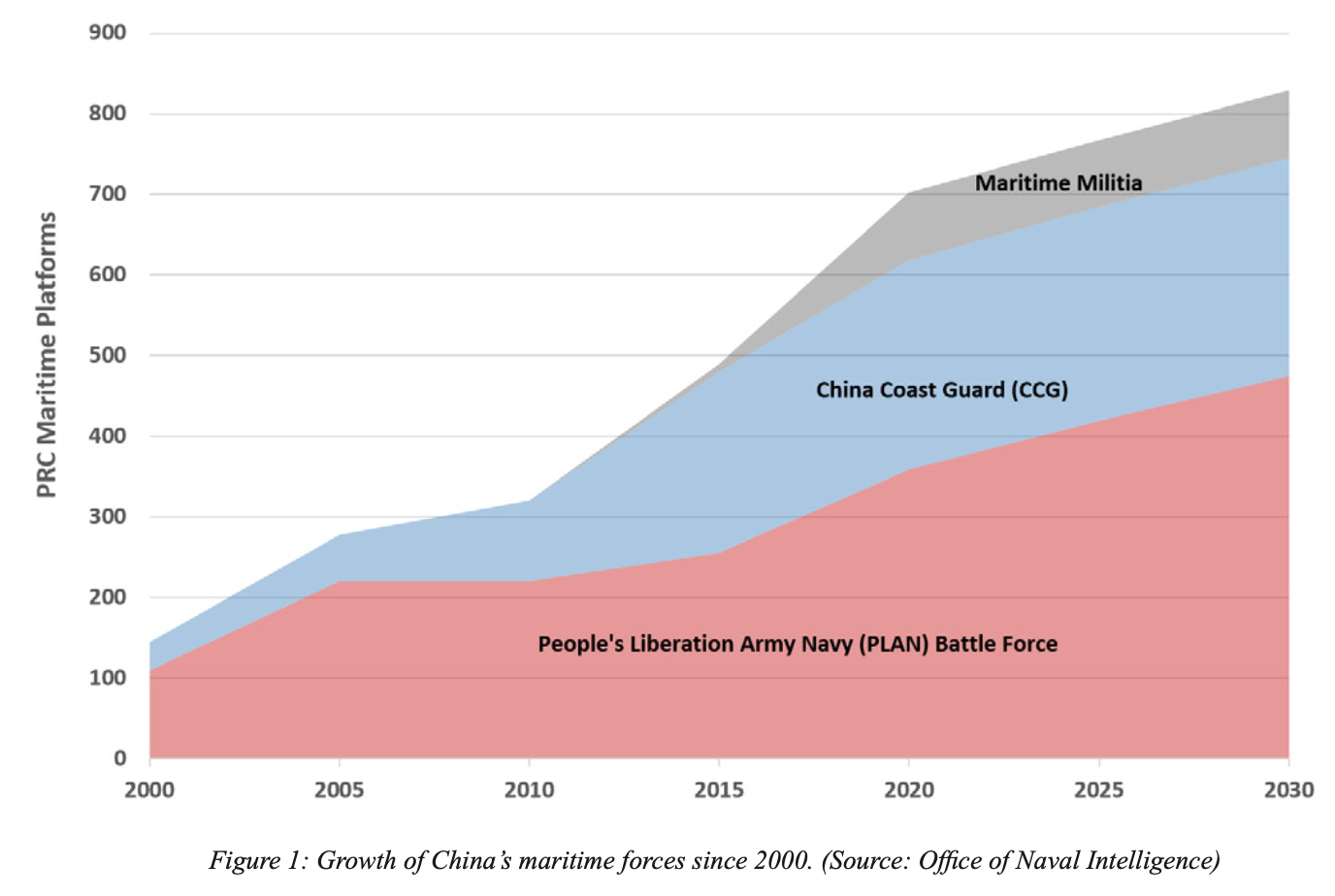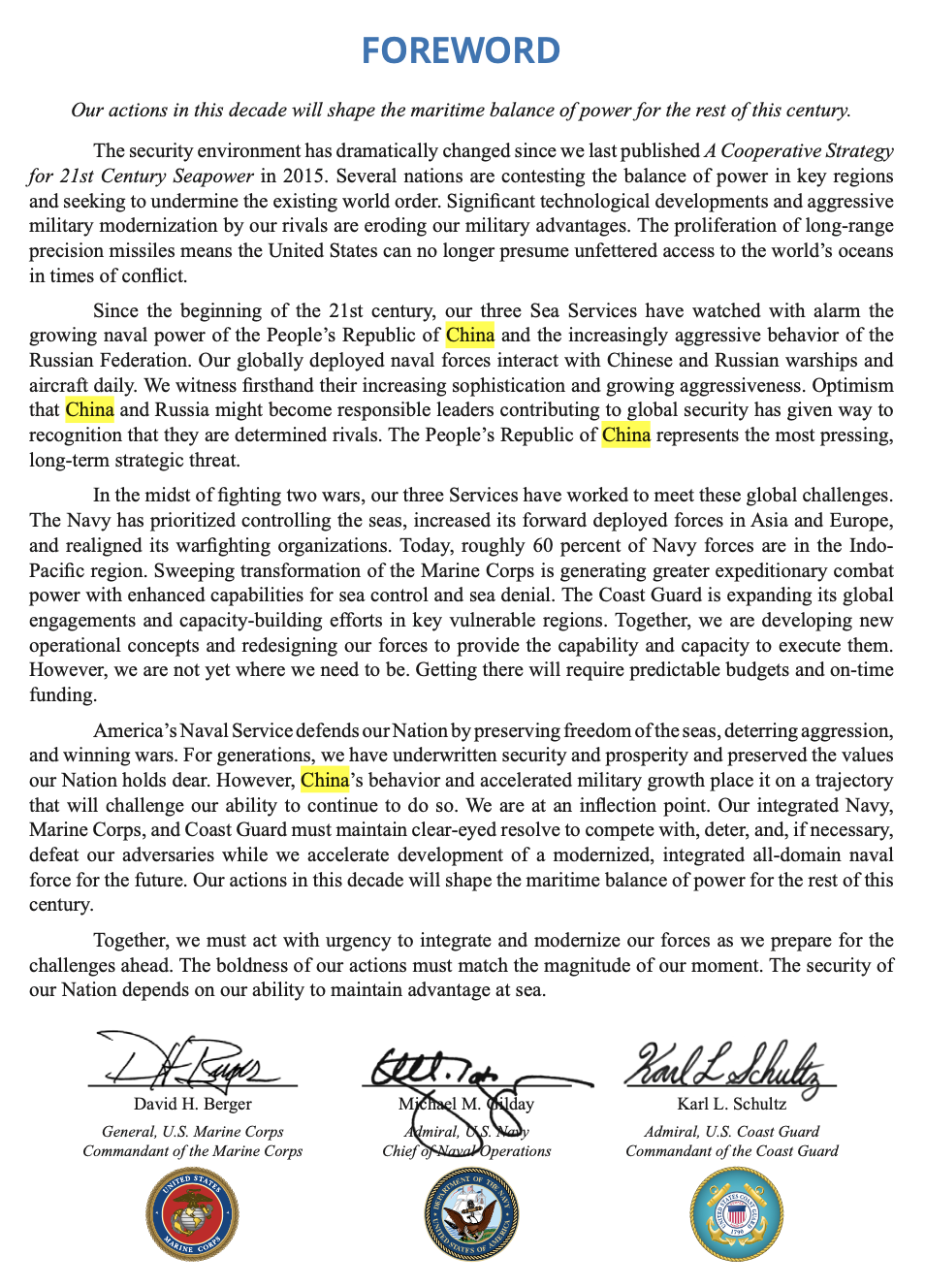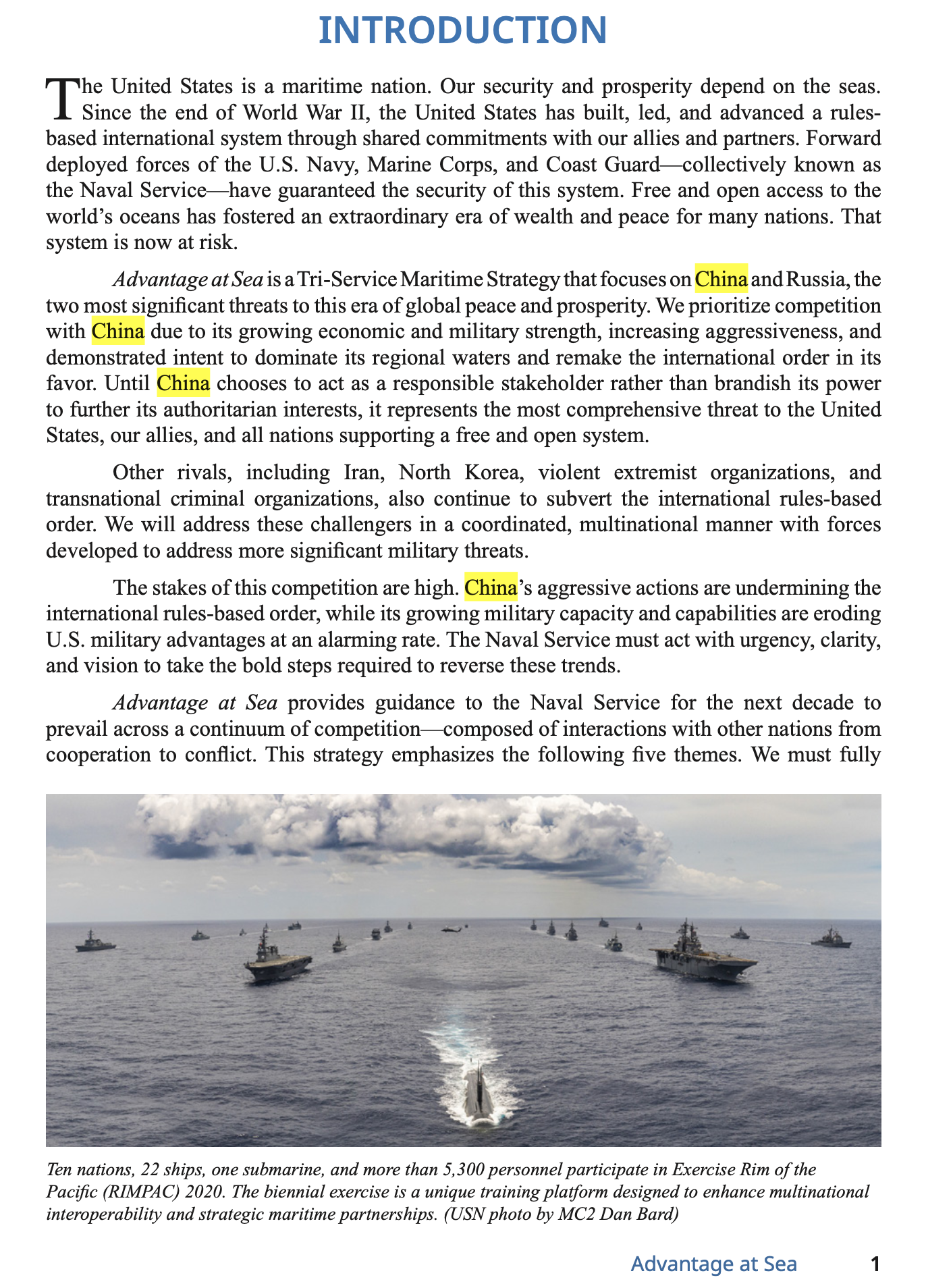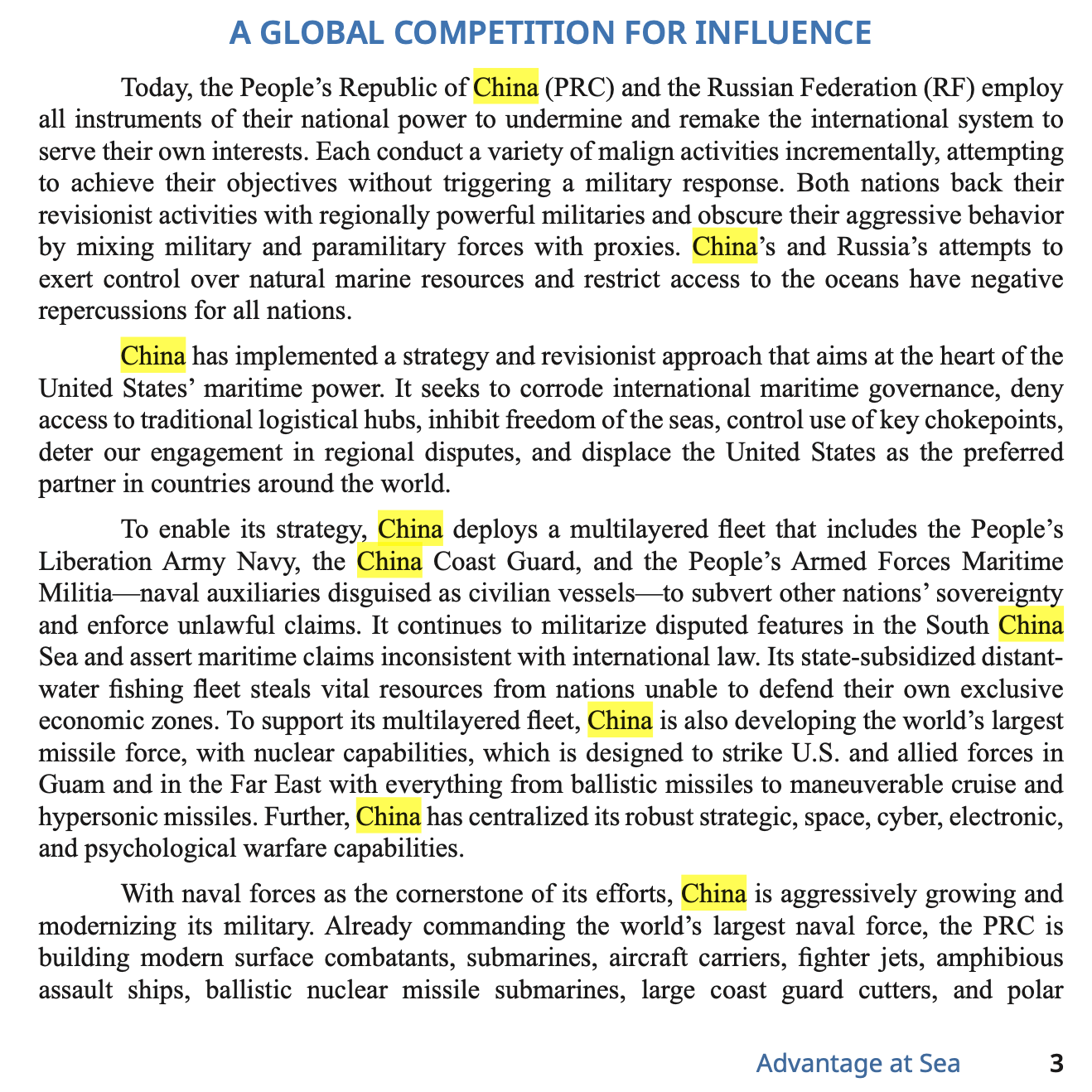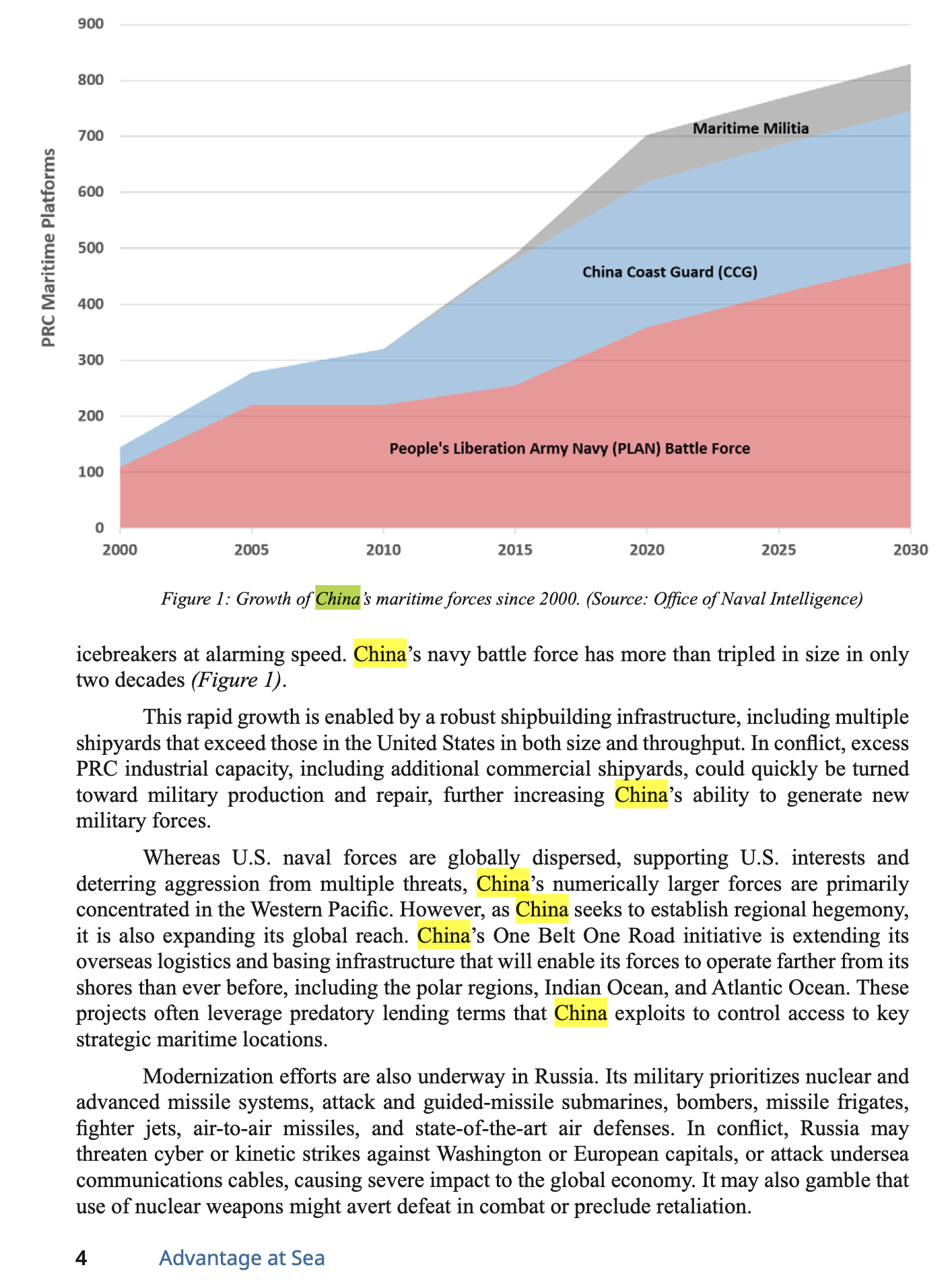Advantage at Sea: Prevailing with Integrated All-Domain Naval Power
A well-written, high-impact, must-read document. Includes a great graphic showing the very first public estimates of China Maritime Militia ship numbers that I’ve seen (courtesy of the U.S. Office of Naval Intelligence)!
Advantage at Sea: Prevailing with Integrated All-Domain Naval Power (Washington, DC: U.S. Navy, U.S. Marine Corps, and U.S. Coast Guard, 17 December 2020).
Click here to download a cached copy.
U.S. Navy explanation of release:
The document provides strategic guidance on how the sea services will prevail in day-to-day competition, crisis, and conflict over the next decade. It also directs the services to deepen tri-service integration, aggressively pursue force modernization, and continue robust cooperation with allies and partners.
“Our integrated Navy, Marine Corps, and Coast Guard must maintain clear-eyed resolve to compete with, deter, and, if necessary, defeat our adversaries while we accelerate development of a modernized, integrated all-domain naval force for the future,” wrote Chief of Naval Operations Adm. Michael M. Gilday, Marine Corps Commandant Gen. David H. Berger, and Coast Guard Commandant Adm. Karl L. Schultz in the strategy’s forward. “Our actions in this decade will shape the maritime balance of power for the rest of this century.”
Advantage at Sea places particular focus on China and Russia due to their increasing maritime aggressiveness, demonstrated intent to dominate key international waters and clear desire to remake the international order in their favor.
“China’s and Russia’s revisionist approaches in the maritime environment threaten U.S. interests, undermine alliances and partnerships, and degrade the free and open international order,” the document states. “Moreover, China’s and Russia’s aggressive naval growth and modernization are eroding U.S. military advantages.”
The strategy also emphasizes the maritime domain is integral not only to America’s security and prosperity but to those of all nations. The oceans connect global markets, provide essential resources, and link societies and businesses. Shared interests create opportunities for greater cooperation with allies and partners.
“As Sailors, we are on the leading edge of Great Power Competition each and every day,” said Gilday. “Sea control, power projection and the capability to dominate the oceans must be our primary focus. Our forces must be ready today, and ready tomorrow, to defend our nation’s interests against potential adversaries at any time. This strategy helps us do exactly that.”
The strategy directs the Services to pursue an agile and aggressive approach to force modernization and experimentation. The future fleet will combine legacy assets with new, smaller ships, lighter amphibious ships, modernized aircraft, expanded logistics, resilient space capabilities, and optionally manned and unmanned platforms. To succeed in a dynamic operating environment, the Services will also invest in warfighter development, delivering innovative training and education to ensure our Sailors, Marines, and Coast Guardsmen remain the world’s premier naval force.
Advantage at Sea also reflects the dual roles of the Service Chiefs: advising on the employment of forces in day-to-day competition, crisis and conflict, and developing a modernized future force that deters potential adversaries and advances and defends U.S. interests.
“The Marine Corps is conducting a sweeping force design transformation to fulfill our role as the Nation’s expeditionary force-in-readiness while simultaneously modernizing the force in accordance with the operating environment described in the National Defense Strategy and the tri-Service maritime strategy. We must embrace new ways of operating within the concepts of integrated U.S. naval power to deter future adversaries and generate better strategic choices,” said Berger.
As the Services pursue greater integration, to include training and education; capabilities and networks; plans, exercises, and experiments; analysis and wargaming; investments and innovation; and force design, Advantage at Sea states they will collaborate with allies and partners to build capability, enhance interoperability, and generate unity of effort. Alongside allies and partners, the Services will be able to establish sea denial and sea control where and when needed, project power, and hold critical adversary targets at risk.
“As the only military service in the Department of Homeland Security, the U.S. Coast Guard provides unique multi-mission and intelligence capabilities to complement the ability of our Marines and Navy to protect our national interests when necessary and deliver lethality across the globe,” said Schultz. “Our hallmark is working daily with partner agencies, sister sea services, and international navies and coast guards to counter maritime coercion and uphold the rules-based order – partnerships work.”
To read the full strategy, please visit: Advantage at Sea
China-related content from document:
FOREWORD
Our actions in this decade will shape the maritime balance of power for the rest of this century.
The security environment has dramatically changed since we last published A Cooperative Strategy for 21st Century Seapower in 2015. Several nations are contesting the balance of power in key regions and seeking to undermine the existing world order. Significant technological developments and aggressive military modernization by our rivals are eroding our military advantages. The proliferation of long-range precision missiles means the United States can no longer presume unfettered access to the world’s oceans in times of conflict.
Since the beginning of the 21st century, our three Sea Services have watched with alarm the growing naval power of the People’s Republic of China and the increasingly aggressive behavior of the Russian Federation. Our globally deployed naval forces interact with Chinese and Russian warships and aircraft daily. We witness firsthand their increasing sophistication and growing aggressiveness. Optimism that China and Russia might become responsible leaders contributing to global security has given way to recognition that they are determined rivals. The People’s Republic of China represents the most pressing, long-term strategic threat.
In the midst of fighting two wars, our three Services have worked to meet these global challenges. The Navy has prioritized controlling the seas, increased its forward deployed forces in Asia and Europe, and realigned its warfighting organizations. Today, roughly 60 percent of Navy forces are in the Indo-Pacific region. Sweeping transformation of the Marine Corps is generating greater expeditionary combat power with enhanced capabilities for sea control and sea denial. The Coast Guard is expanding its global engagements and capacity-building efforts in key vulnerable regions. Together, we are developing new operational concepts and redesigning our forces to provide the capability and capacity to execute them. However, we are not yet where we need to be. Getting there will require predictable budgets and on-time funding.
America’s Naval Service defends our Nation by preserving freedom of the seas, deterring aggression, and winning wars. For generations, we have underwritten security and prosperity and preserved the values our Nation holds dear. However, China’s behavior and accelerated military growth place it on a trajectory that will challenge our ability to continue to do so. We are at an inflection point. Our integrated Navy, Marine Corps, and Coast Guard must maintain clear-eyed resolve to compete with, deter, and, if necessary, defeat our adversaries while we accelerate development of a modernized, integrated all-domain naval force for the future. Our actions in this decade will shape the maritime balance of power for the rest of this century.
Together, we must act with urgency to integrate and modernize our forces as we prepare for the challenges ahead. The boldness of our actions must match the magnitude of our moment. The security of our Nation depends on our ability to maintain advantage at sea.
David H. Berger, General, U.S. Marine Corps Commandant of the Marine Corps
Michael M. Gilday, Admiral, U.S. Navy Chief of Naval Operations
Karl L. Schultz, Admiral, U.S. Coast Guard Commandant of the Coast Guard
p. 1
INTRODUCTION
The United States is a maritime nation. Our security and prosperity depend on the seas. Since the end of World War II, the United States has built, led, and advanced a rules-based international system through shared commitments with our allies and partners. Forward deployed forces of the U.S. Navy, Marine Corps, and Coast Guard—collectively known as the Naval Service—have guaranteed the security of this system. Free and open access to the world’s oceans has fostered an extraordinary era of wealth and peace for many nations. That system is now at risk.
Advantage at Sea is a Tri-Service Maritime Strategy that focuses on China and Russia, the two most significant threats to this era of global peace and prosperity. We prioritize competition with China due to its growing economic and military strength, increasing aggressiveness, and demonstrated intent to dominate its regional waters and remake the international order in its favor. Until China chooses to act as a responsible stakeholder rather than brandish its power to further its authoritarian interests, it represents the most comprehensive threat to the United States, our allies, and all nations supporting a free and open system.
Other rivals, including Iran, North Korea, violent extremist organizations, and transnational criminal organizations, also continue to subvert the international rules-based order. We will address these challengers in a coordinated, multinational manner with forces developed to address more significant military threats.
The stakes of this competition are high. China’s aggressive actions are undermining the international rules-based order, while its growing military capacity and capabilities are eroding U.S. military advantages at an alarming rate. The Naval Service must act with urgency, clarity, and vision to take the bold steps required to reverse these trends.
p. 3
A GLOBAL COMPETITION FOR INFLUENCE
Today, the People’s Republic of China (PRC) and the Russian Federation (RF) employ all instruments of their national power to undermine and remake the international system to serve their own interests. Each conduct a variety of malign activities incrementally, attempting to achieve their objectives without triggering a military response. Both nations back their revisionist activities with regionally powerful militaries and obscure their aggressive behavior by mixing military and paramilitary forces with proxies. China’s and Russia’s attempts to exert control over natural marine resources and restrict access to the oceans have negative repercussions for all nations.
China has implemented a strategy and revisionist approach that aims at the heart of the United States’ maritime power. It seeks to corrode international maritime governance, deny access to traditional logistical hubs, inhibit freedom of the seas, control use of key chokepoints, deter our engagement in regional disputes, and displace the United States as the preferred partner in countries around the world.
To enable its strategy, China deploys a multilayered fleet that includes the People’s Liberation Army Navy, the China Coast Guard, and the People’s Armed Forces Maritime Militia—naval auxiliaries disguised as civilian vessels—to subvert other nations’ sovereignty and enforce unlawful claims. It continues to militarize disputed features in the South China Sea and assert maritime claims inconsistent with international law. Its state-subsidized distant-water fishing fleet steals vital resources from nations unable to defend their own exclusive economic zones. To support its multilayered fleet, China is also developing the world’s largest missile force, with nuclear capabilities, which is designed to strike U.S. and allied forces in Guam and in the Far East with everything from ballistic missiles to maneuverable cruise and hypersonic missiles. Further, China has centralized its robust strategic, space, cyber, electronic, and psychological warfare capabilities.
With naval forces as the cornerstone of its efforts, China is aggressively growing and modernizing its military. Already commanding the world’s largest naval force, the PRC is building modern surface combatants, submarines, aircraft carriers, fighter jets, amphibious assault ships, ballistic nuclear missile submarines, large coast guard cutters, and polar
p. 4
icebreakers at alarming speed. China’s navy battle force has more than tripled in size in only two decades (Figure 1).
This rapid growth is enabled by a robust shipbuilding infrastructure, including multiple shipyards that exceed those in the United States in both size and throughput. In conflict, excess PRC industrial capacity, including additional commercial shipyards, could quickly be turned toward military production and repair, further increasing China’s ability to generate new military forces.
Whereas U.S. naval forces are globally dispersed, supporting U.S. interests and deterring aggression from multiple threats, China’s numerically larger forces are primarily concentrated in the Western Pacific. However, as China seeks to establish regional hegemony, it is also expanding its global reach. China’s One Belt One Road initiative is extending its overseas logistics and basing infrastructure that will enable its forces to operate farther from its shores than ever before, including the polar regions, Indian Ocean, and Atlantic Ocean. These projects often leverage predatory lending terms that China exploits to control access to key strategic maritime locations. … …
p. 5
In the event of conflict, China and Russia will likely attempt to seize territory before the United States and its allies can mount an effective response—leading to a fait accompli. Each supports this approach through investments in counter-intervention networks. Each seeks to shift the burden of escalation by reinforcing annexed territory with long-range precision-strike weapons and make a military response to an invasion seem disproportionately costly. … …
PROBLEM STATEMENT
China’s and Russia’s revisionist approaches in the maritime environment threaten U.S. interests, undermine alliances and partnerships, and degrade the free and open international order. Moreover, China’s and Russia’s aggressive naval growth and modernization are eroding U.S. military advantages. Unchecked, these trends will leave the Naval Service unprepared to ensure our advantage at sea and protect national interests within the next decade.
p. 7
Naval forces’ unique attributes generate options and decision space for national leadership, providing credible deterrence and prompt crisis response worldwide, regardless of access to overseas bases. Every day, the Naval Service operates on the front lines of global competition, interacting with China’s and Russia’s forces in every domain. Agile, mobile, expeditionary, scalable, sustainable, versatile, networked, and lethal, we provide critical advantages over our competitors through our ability to use the vast oceans to maneuver and sustain our forces globally. Working alongside our allies and partners, our operations, exercises, and engagements must set the conditions for a future in which our rivals are deterred from malign behaviors and aggression—and, if deterrence fails, a future in which they are defeated.
p. 9
To counter China’s and Russia’s revisionist approaches in the maritime environment and to set global maritime conditions that support National Defense Strategy objectives, the Naval Service, as part of the Joint Force, will:
- Defend the homeland from attack and protect the U.S. marine transportation system
- Preserve a stable and secure global maritime environment that is free, open, and advances prosperity through transit, trade, and lawful pursuit of natural resources
- Defend allies from aggression and enable partners to counter coercion and subversion
- Expand collaboration and interoperability with allies and partners, and reinforce favorable balances of maritime power
- Deter strategic, nuclear, conventional, and cyber aggression to protect U.S. vital interests
- In the event of conflict, deny adversaries their objectives, defeat adversary forces while managing escalation, and set the conditions for favorable conflict terminationGiven the scope of our global mission and the scale of our challenges, we must set priorities and manage risk. We cannot operate everywhere, at all times, with equal effectiveness. Therefore, the Naval Service will prioritize: Competition with the PRC over other challengers. China is the only rival with the combined economic and military potential to present a long-term, comprehensive challenge to the United States. Naval Service operations and force posture will focus on countering PRC malign behavior globally and strengthening regional deterrence in the Indo-Pacific region.
p. 12
We cannot cede influence in areas of emerging day-to-day competition, including U.S. regional waters and the Arctic. The coming decades will bring changes to the Arctic region that will have a significant impact on the global economy, given its abundance of natural resources and strategic location. China views this region as a critical link in their One Belt One Road initiative. Arctic nations are reopening old bases, moving forces, and reinvigorating regional exercises. These trends will persist in the decades ahead. We must continue to operate forward and posture our forces appropriately.
p. 15
To reverse the erosion of U.S. military advantages from China’s and Russia’s aggressive naval growth and modernization, the Navy, Marine Corps, and Coast Guard, will develop integrated all-domain naval forces that, as part of the Joint Force, can:
- Recruit, train, educate, manage, and retain diverse, versatile, professional personnel— active, reserve, and civilian—able to adapt and succeed in ambiguous, dynamic environments
- Generate sufficient readiness and capacity to conduct and logistically sustain forward operations, support experimentation, and preserve combat-ready surge forces
- Expand capabilities and concepts to expose, disrupt, and deny malign activities in day-to-day competition
- Operate with allies and partners in day-to-day competition, crisis, and conflict
- Operate, survive, and sustain themselves under threat in a contested, persistently surveilled environment
- Provide persistent, all-domain, long-range precision fires, supported by agile, resilient, integrated networks, to deny adversary objectives and destroy adversary forces
- Operate and maintain the most survivable leg of the Nation’s nuclear deterrent triad
p. 21
CONCLUSION
In this era of long-term strategic competition, the Naval Service must be prepared to defend our national interests, anywhere and anytime. China’s and Russia’s coercive actions, their attempts to undermine our alliances and partnerships, and their aggressive military modernization efforts pose an undeniable threat to global security and prosperity. … … …

